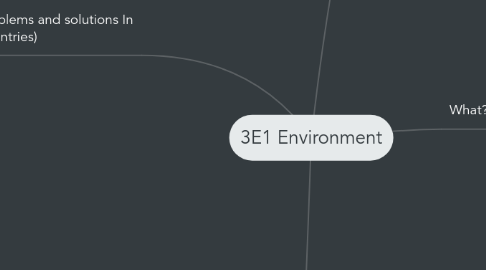
1. How? (What people say about environment)
1.1. Its bad
1.2. Its an impending doom
1.3. A problem that has to be resolved
1.4. “Earth provides enough to satisfy every man's needs, but not every man's greed.” ― Mahatma Gandhi
1.5. "The environment is everything that isn't ours"- Albert Einstein
1.6. What's the use of a fine house if you haven't got a tolerable planet to put it on?-Henry David Thoreau
2. Where? (Problems and solutions In different countries)
2.1. China
2.1.1. Air pollution
2.1.1.1. Air pollution is killing about 4,400 people in China every single day, according to a new study.
2.1.1.2. Researchers calculated that about 1.6 million people in China die every year from health issues caused by the country’s notoriously polluted air.
2.1.1.2.1. The Telegraph reported a case of an 8-year-old girl who had contracted lung cancer, becoming the youngest victim of lung cancer in China. Doctors pointed out that the likely cause was exposure of air pollution, specifically fine particulates from vehicles.
2.1.1.3. This can cause a variety of health problems, including asthma, lung cancer, heart disease and stroke.
2.1.2. Water pollution
2.1.2.1. The water resources of China are affected by both severe water shortages and severe water pollution
2.1.2.1.1. Half of China's population lacks safe drinking water. Nearly two thirds of China's rural population---more than 500 million people---use water contaminated by human and industrial waste
2.1.2.1.2. Water consumed by people in China contains dangerous levels of arsenic, fluorine and sulfates.
2.1.2.1.3. China's three great rivers---the Yangtze, Pearl and Yellow River---are so filthy that it is dangerous to swim or eat fish caught in them.
2.1.2.2. Sources of Water Pollution
2.1.2.2.1. Major polluters include chemical factories, drug manufactures, fertilizer makers, tanneries, paper mills.
2.1.3. Air Polllution
2.1.3.1. Problems
2.1.3.1.1. Many People in China are dying from air pollution. They're daily lives are also affected.
2.1.3.1.2. It is affecting other countires.
2.1.3.2. Solutions
2.1.3.2.1. The most basic solution for air pollution is to end its root causes: quit coal and move away from fossil fuels, replacing them with clean, renewable energy.
2.1.3.2.2. Four-color alert system
2.1.3.3. Causes
2.1.3.3.1. Air Pollution is primarily caused by the burning of coal in factories and power plants, as well as vehicle use.
2.1.3.4. Air pollution has become a major issue in China, and poses a threat to Chinese public health.
2.2. Indonesia
2.2.1. Haze
2.2.1.1. Causes
2.2.1.1.1. Land and forest fires in South Sumatra, Indonesia. Due to due to illegal burning on agricultural and peat lands.
2.2.1.1.2. At the root of the problem is the practice of forest clearance known as slash and burn, where land is set on fire as a cheaper way to clear it for new planting.
2.2.1.2. Problems
2.2.1.2.1. Indonesia’s tropical forests represent some of the most diverse habitats on the planet. The current fire outbreak adds to decades of existing deforestation by palm oil, timber and other agribusiness operators, further imperilling endangered species such as the orangutan.
2.2.1.2.2. 19 people have died and an estimated 500,000 cases of respiratory tract infections have been reported since the start of the fires.
2.2.1.2.3. It has affected other countries
2.2.1.3. Solutions
2.2.1.3.1. Ending the practice of slash and burn is vital.
2.2.1.3.2. Smallholders need assistance and incentives to pursue alternative, less harmful practices of forest management.
2.2.1.3.3. Many are calling on the Indonesian government to step up.
2.2.1.3.4. Another major contribution to reducing future fires would be an up-to-date online, searchable land registry. Land tenure in Indonesia is often unknown or disputed, making it difficult to establish where responsibility lies.
3. Who? (Whose responsibility)
3.1. School
3.1.1. Students
3.1.2. Teachers
3.2. General Public
3.3. Government
4. What? (Activities that help and harm)
4.1. Pollution
4.1.1. Air
4.1.1.1. Factories release poisonous gases to the air
4.1.1.2. Poisonous gases eg.Carbon dioxide,Carbon Monoxide,Sulfur dioxide
4.1.1.3. Acid Rain
4.1.1.4. Haze
4.1.2. Land
4.1.2.1. Litter
4.1.3. Water
4.1.3.1. Factories release wastes in seas and oceans
4.1.3.2. Sewage is sometimes released into the ocean and seas
4.2. Deforestation
4.2.1. Removing trees and other plants to increase areas of cultivation causes habitat loss and threatens the survival of numerous species of animals and plants.
4.3. Haze
4.3.1. Indonesia
4.4. Global Warming
4.4.1. North & South poles starting to melt
4.4.2. Earth is getting hotter day by day
4.4.3. Droughts are more often
4.4.3.1. Evidence:Precipitation has declined in the tropics and subtropics since 1970. Southern Africa, the Sahel region of Africa, southern Asia, the Mediterranean, and the U.S. Southwest, for example, are getting drier.
4.4.4. Evidence: Just in the last 650,000 years there have been seven cycles of glacial advance and retreat, with the abrupt end of the last ice age about 7,000 years ago marking the beginning of the modern climate era — and of human civilization.
4.4.5. Evidence:Earth is already showing many signs of worldwide climate change. Average temperatures have climbed 1.4 degrees Fahrenheit (0.8 degree Celsius) around the world since 1880, much of this in recent decades, according to NASA's Goddard Institute for Space Studies.
